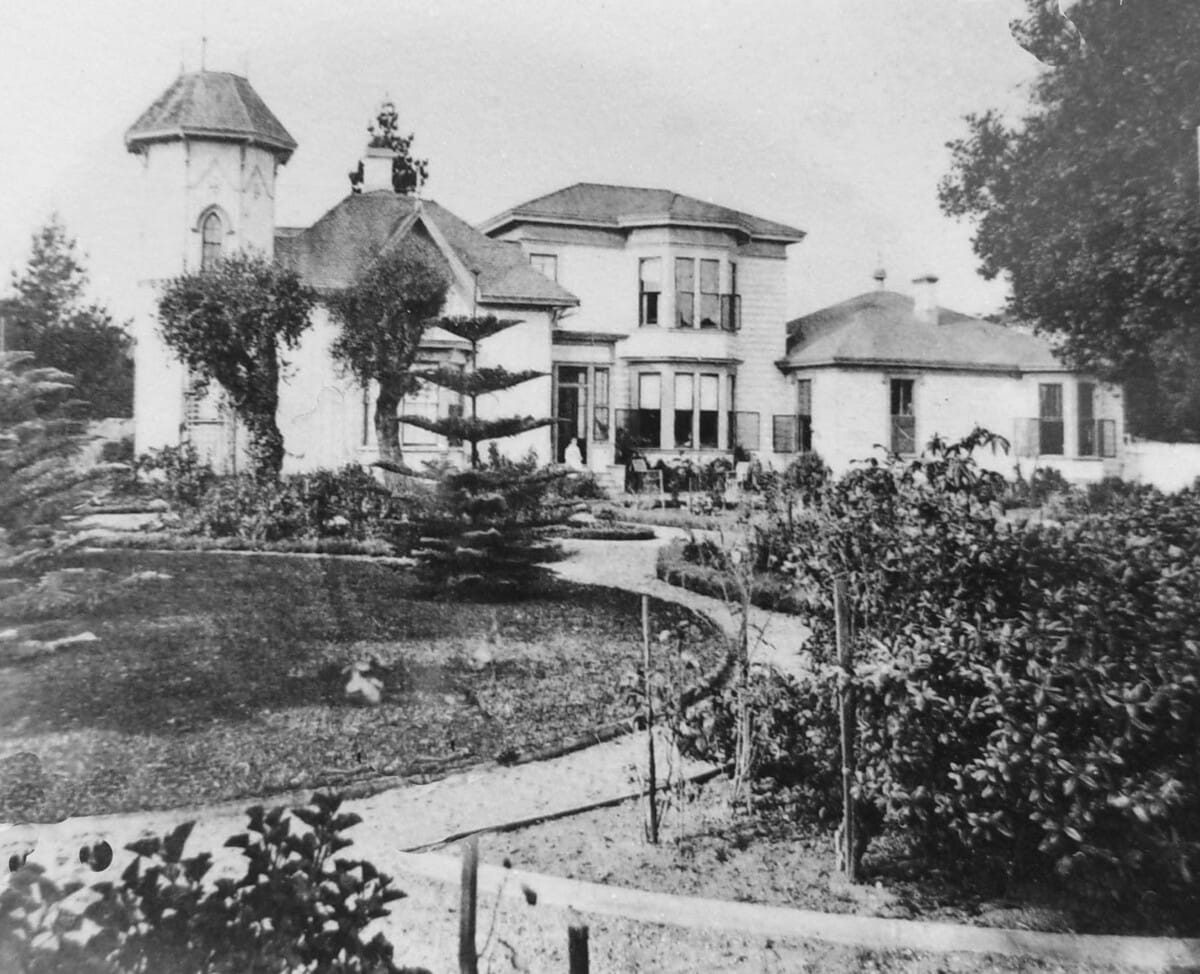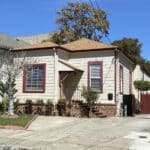Before 1872, visitors found three independent towns — Alameda, Encinal, and Woodstock — on the Alameda peninsula. William Worthington Chipman and Gideon Aughinbaugh, who purchased the peninsula from Don Antonio Peralta in 1851, laid out the town of Alameda with its heart near today’s Peach and Washington streets on the East End.
That same year J. F. Hibbard signed a promissory note for $4,666.66 to purchase 656.6 acres in the center of the peninsula. He created the town of Encinal with its hub at today’s Union Street and Pacific Avenue. In 1864 A. A. Cohen had the town of Woodstock surveyed primarily to accommodate workers on his San Francisco & Alameda Railroad. The center of the peninsula’s third town stood at modern-day Third Street and Pacific Avenue.

In 1872, Daily Evening Encinal publisher Frederick Keller Krauth spearheaded a drive that united these three small towns into the city of Alameda. Krauth was a 49er who had tried his luck on the American River’s Mormon Bar. With no gold dust to show for his efforts, he moved to Placerville, where he worked for the Placerville Democrat newspaper. In 1869 he brought his skills to Alameda, where he started his own newspaper.
The three towns had stood as one for eleven years in 1883 when Myron W. Wood published the History of Alameda County, California. His historian, J. P. Monro-Fraser, sat across the table with Alameda co-founder Gideon Aughinbaugh and interviewed him for the book
Aughinbaugh told Monro-Fraser that when he arrived in San Francisco, he decided not to pursue his trade as a carpenter. Instead Gideon and his wife, Elizabeth, decided to go into the more lucrative grocery business; they opened a store near today’s First and Mission streets.
As they sold foodstuffs to their neighbors, the Aughinbaughs noticed a vein of gold that they hoped to mine. This gold was not in the far-away Sierra Nevada, but right in front of them on their grocery store shelves: fresh fruit. The Aughinbaughs were astonished at how much money people were willing to pay for fruits like peaches, apples and cherries. They dreamed of a way to raise their own fruit, but knew they needed land to do this.
Perhaps Gideon and Elizabeth had visited the reading room and “intelligence office” on Clay Street just a block down from Portsmouth Plaza. They could keep up on news in the East by reading the newspapers that Vermont native William Worthington Chipman kept there. Historian Imelda Merlin tells us that the Aughinbaughs would have found “newspapers from the chief towns in the United States and a ‘Miners’ and Strangers’ Register’” at Chipman’s office. Chipman headed west early in life, first to Ohio where he worked a school principal and studied law. He came to San Francisco in 1850. In September of that year he and Aughinbaugh first set foot on the Bolsa de Encinal (as the Alameda peninsula was known).
Aughinbaugh recalled that he and his partner “subleased from Depachier and Le Maitre 160 acres fronting on San Francisco Bay.” (The men Aughinbaugh remembered as Depachier and Le Maitre were Joseph Depassier and Balthazar Maitre who had leased a portion of the Bolsa de Encinal from Don Antonio Peralta.)
In 1895, two years before his death, Aughinbaugh granted a second interview; this one to the Alameda Daily Argus. In that discussion Aughinbaugh recalled ordering 1,000 fruit trees, which arrived in May 1851 in an express shipment. By July the partners had their first peaches; in September they were ready to bring fruit to market.
The town of Alameda: One month later on October 22, 1851, they purchased the peninsula from Don Antonio Peralta. In order to raise the money to pay for their venture, the partners sold portions of their land to other enterprising Yankees, but kept the East End for themselves. In 1853, they hired surveyor J. F. Stratton to survey the Town of Alameda. They teamed up with Stratton to lay out streets. They named the byways running east-west for famous Americans like George Washington and Henry Clay; names for the north-south streets reflected the pair’s enterprises: Peach, Market, and Post to name just three. Chipman and Aughinbaugh set up a prefabricated home near today’s Post and Adams streets.
An Alameda County commission visited the town in 1854. The commissioners were pleased to see not just an artesian well, but a plank road (High Street), a shell road and C. Halloway’s home (apparently the only structure covered with plaster).

The town of Encinal: James Hibbard, a man the 1852 California census listed as 35-year-old physician “J. F. Hebbrid,” stepped up and promised to pay Chipman and Aughinbaugh $4,666.66 for 656.6 acres in the center of the peninsula. Later court records revealed, however, that the good doctor reneged and failed to pay for his property, which was first known as “Hibbard’s Third” and later “Lands Adjacent to the Town of Encinal.”
In 1854 Hibbard laid out that town along the peninsula’s northern shore at the foot of today’s Grand Street and near the 3,000-foot-long wharf that Charles Minturn already had in place. Besides the wharf the town also had a tannery and strawberry fields. Perhaps to escape the smell emanating from the tannery, Hibbard fished redwood logs out of today’s Oakland Estuary and build himself a house on his property’s south shore.
Hibbard named his property’s east-west streets for birds — Condor, Falcon, and Quail, for example, underwent name changes to Clement, Buena Vista, and Santa Clara avenues, respectively. Hibbard gave the north-south byways names that reflected creatures of the sea: among them Leviathan, Pike, and Minnow, which thankfully morphed into Grand, Union and Chestnut streets. Two streets survive from Hibbard’s naming scheme: Eagle and Paru.

The town of Woodstock: Many Alamedans associate Woodstock with the Alameda Housing Authority’s 1941 housing project on the West End. The area has a richer history that stretches back to 1851 or early 1852, when Charles Bowman received a deed from Chipman and Aughinbaugh for land here. The Town of Woodstock was the 1864 creation of A. A. Cohen and his partner J. D. Farwell.
A young Jack London once lived nearby; terra cotta, borax, and oil industries all thrived here, and an early California governor made his home here.
Bowman purchased 144 acres on today’s West End from Chipman and Aughinbaugh. Instead of a fence, Bowman chose to build a ditch to define his eastern property boundary. Quickly dubbed “Bowman’s Ditch,” it ran in a north-south direction from the marshlands to San Francisco Bay. The ditch ran through today’s Woodstock Park, through about where Marshall Way and Pacific Avenue intersect and then just east of today’s Fourth Avenue.
George Bird arrived, purchased land and built a hotel, a resort for hunters. Painter Joseph Lee has left us a wonderful likeness of the hotel and its owner. Cohen commissioned the painting in 1868, four years after he founded the town of Woodstock and named it for Bird’s hometown in England. Some of the street names in the town come down to use today, monikers like Spruce and Cypress. Names the Cohen chose to remember his partner Farwell and his patron J. G. Kellogg have disappeared.

Henry Haight chose the West End for his estate. He is best remembered as the governor who signed the documents that breathed life into today’s University of California. Jack London lived here, too. He moved to the West End with his family. He attended the West End Primary School, which later morphed into Longfellow School.
Although the nineteenth-century towns of Alameda, Encinal, and Woodstock have long disappeared, their vestiges remain. You just have to know where to look.
Dennis Evanosky is the Editor of the Alameda Post. Reach him at [email protected].



